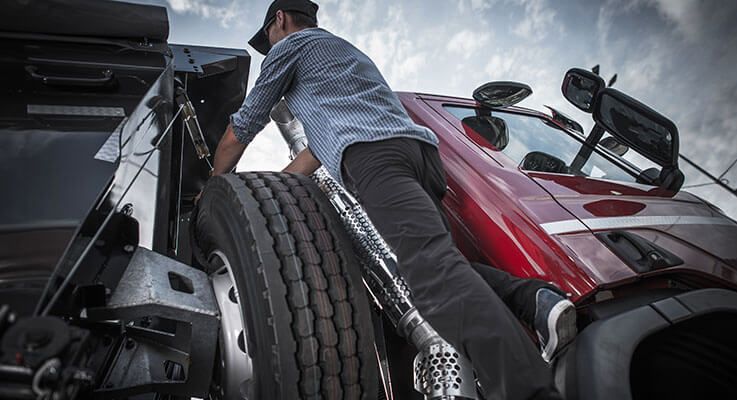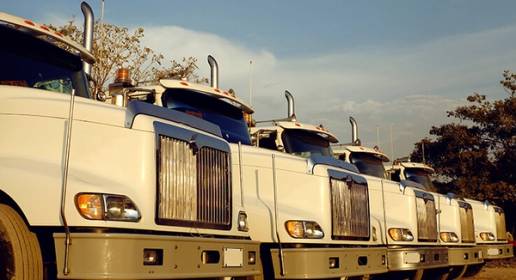Blog

Read This Dot Pre-Trip Inspection Checklist before You Next Haul
General
For truckers, DOT pre-trip inspection is perhaps the most critical aspect of preparing for each trip. Maintaining safety while on the road is essential, and a pre-trip inspection is the best way to ensure this. Although there is no specific duration that each DOT truck inspection must fit into, there are a handful of DOT rules and regulations that can help when inspecting your truck. If any issues are noticed during this DOT truck inspection, you will have the opportunity of addressing them before embarking on your trip.
Read This DOT Pre-Trip Inspection Checklist:
Clean up your cab
When it comes to a DOT pre-trip inspection, many owner operator truckers overlook keeping their cab clean but instead concentrate on other activities. However, having a dirty or messy cab gives you away as an individual who cannot take care of his workplace. So if you would like to avoid making an unwanted impression, it's necessary for you to clean up your cab.
- Keep loose objects in a storage box or travel organizer that can make your cab look messy
- Keep your windshield clean to ensure you have the best visibility
- Clean your dashboard to remove dust
- All objects should be correctly and properly mounted or secured
- Vacuum on a regular basis to add longevity to your interior and prevent food particles taking on a life of their own
Check under the hood
Sometimes, unusual items may be attached to your truck, and these seemingly harmless items can lead to problems when you are on the road. Therefore, it would help if you took your time to examine the hood for any unexpected objects.
After opening the hood, some of the things you should check include air hoses and electrical wiring, brake chambers, radiator, different sides of the engine, fuel filter, and air conditioning compressor. Also inspect the fuel pump, water pump, windshield washer fluid oil, accessory drive belts, shock absorbers, hub oil, power steering reservoir, steering gearbox, and so on.
If you find any unusual items attached to any of these parts, be sure to remove them before starting any trip.
Chock the wheels of your truck properly
One of the essential DOT regulations for truck drivers is chocking the wheels of their truck when conducting a pre-trip inspection. Chocking the wheels will prevent your truck from any forms of accidental movement when you are behind the wheel. This will require running the engine of the truck, testing the braking system, and inspecting the wheels from time to time.
Assess the engine block
Leaks, wear, fraying and cracking are often commonly seen in many trucks, and these are capable of making you lose a lot of money as well as wasting time when your truck suddenly breaks down on the road. Therefore, your DOT pre-trip inspection checklist should include:
- Assessing fluid leaks
- Inspecting the hoses
- Checking the fan belts and other parts for wears, fraying or cracking
Inspect the oil and coolant levels
DOT rules and regulations necessitate the inspection of the level of oil, power steering fluids, fuel, coolants, and other fluids before embarking on any trip. You should also never forget to check the seals or caps of the oil filler and power steering fluid. If the caps or seals are loose, tighten them to avoid any problems. The windshield wiper fluid level should also be carefully checked.
Check the wires
During your DOT truck inspection, you should be on the lookout for the wires. If you see any bare or exposed wires or those that are out of place, you should ensure that the wires are fixed into the proper positions. It would help if you always remembered that any problems with these wires could lead to fire outbreaks; therefore, do not endanger your life or the lives of other individuals.
Test the braking system
DOT regulations for truck drivers highlight the importance of the braking system to a truck. One of the most frequently used components of a truck, the braking system is susceptible to wear and tear than most other parts. Without a doubt, going on a trip without testing the braking system properly is dangerous.
When testing your braking system as a part of your pre-trip inspection, you should:
- Inspect the system from the inside of the truck
- Check again from the outside of the truck
- Use a slack adjuster for the adjustment of the brake
- Secure the brake chamber airlines so that they are flexible
- Inspect the airlines to know whether they are damaged or leaking
- Check the condition of the seals found on the trailer side as well as the glad hands
- Unless the braking system is in perfect condition, do not go on any trip.
Check your trailer suspension
There are a lot of components found in the trailer suspension; so impatience may cause you to overlook these components. However, by not checking your trailer suspension, you are increasing the susceptibility of your truck to several problems that are capable of disrupting your trip and making you lose money. To avoid such issues, you should check the wheels, tires, and other suspension components. If you notice any modifications, poorly positioned components or unusual items in or around these components, make sure you solve those issues before beginning your next trip.
A few of the suspension components that should be in your pre-trip inspection checklist include slack adjusters, valve caps, tires, air tanks, airlines, wheels, U-bolt, hub oil seals, spring mounts, springs, linings, brake chambers, shock absorbers, torque rods, and drums.
Assess the coupling
Ensure the coupling is in excellent condition by conducting a thorough inspection of the stop blocks, release arm, locking jaw, fifth wheel mount, fifth wheel pivot pins, apron, and slide locking pins. Perchance you are having difficulty getting a clear view of these components, utilize a flashlight.
Check the lights and reflectors
Whether you will be driving at night or not, it is paramount for you to inspect the lights and reflectors of your truck. While the lights will provide the required illumination, the reflectors increase the visibility of your truck at night so that other road users are aware that you are on the road. If you violate these DOT rules and regulations, you can be fined. Therefore, take care of the lights, reflectors and reflective strips of your truck as a part of your pre-trip inspection.
Inspect the seatbelts
There is no denying the fact that a seatbelt can sometimes be a lifesaver, many truckers do not consider the assessment of the seatbelts of their trucks to be necessary to their DOT truck inspection. While inspecting the seatbelts, please pay attention to any signs of wear or fraying that can weaken them. A weakened or damaged seatbelt may not be able to perform its functions to the optimal level; so, do not hesitate to replace the seatbelt. Furthermore, you should replace any seatbelt that does not retract smoothly and quickly.
Nevertheless, inspecting your seatbelts is not enough; you must wear the seatbelt anytime you are driving.
Check and test the emergency kit
At times, truckers travel around with a malfunctioning emergency kit; hence, when accidents occur, they are helpless. Do not put yourself in any unfavorable condition, inspect and test the emergency kit in your truck before any trip. You must rest assured that the fire extinguisher, circuit breakers, warning hazard triangles, and other items are in good condition.
Are the warning hazard triangles reflective and clean? Are the circuit breakers working properly? Do the fire extinguishers have enough pressure whenever you are using them? These are a few of the questions you should answer when inspecting and testing the emergency kit.
Inspect the vehicle once again
After you have checked the components mentioned above properly, you should check them once again. It is possible that you have overlooked certain things during the first inspection; therefore, double checking the truck allows you to detect any previously overlooked problems. Take your time to patiently and carefully inspect each component for the second time.
Evaluate your paperwork
Do not get too immersed in the process of DOT truck inspection and forget to assess your paperwork or else you may get into troubles with the law enforcement agencies. From your permit documents to the trailer ownership documents, vehicle registration, commercial driver license and safety inspection approval sticker, every paperwork counts when you are traveling. Therefore, make sure that these documents are not just valid, but they are also up-to-date.
Conclusion
The essence of conducting a DOT pre-trip inspection is to avoid any problems, so unless you have addressed the problems, your DOT truck inspection is counterproductive. If you truly value your life, you must endeavor to fix the problems before embarking on any trip. Also, it would help if you kept a record of the maintenance activities in your pre-trip inspection logbook.

Noel Ballon
Noel Ballon is a skilled personal finance writer passionate about helping people to succeed financially.
As a guest writer for CASH 1, Noel has shared his knowledge on a variety of financial issues, including budgeting, saving, investing, and retirement planning
Noel has a background in economics and finance with over five years of experience writing in the financial sector.
He works to simplify complicated financial ideas so that people from every area of society may understand them.
When Noel isn't writing, he likes keeping current on the latest financial sector changes and looking for fresh approaches to assisting people in choosing wise financial decisions.





